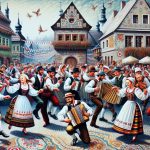
Poland has a rich history, and you can see this clearly in its art, especially through its famous paintings. These paintings cover many years and styles.
For example, Jan Matejko’s ‘The Battle of Grunwald’ shows a big battle scene, while Tamara De Lempicka’s ‘Self-Portrait’ uses modernist techniques to show something personal. Each painting gives us a special look into what Poland was like at the time it was made.
They tell us about the culture, what people liked, and also what was happening in society and politics. To really understand Poland’s history and how its culture has changed over time, looking at these paintings is a must.
The Battle of Grunwald by Jan Matejko
Jan Matejko, a renowned Polish artist, created ‘The Battle of Grunwald’ in 1878. This painting is a significant work that depicts the victory of the Polish-Lithuanian Commonwealth against the Teutonic Knights in 1410. Matejko’s painting is more than just a historical scene; it explores the themes of power, bravery, and cooperation. The way he uses color and detail brings the chaos of battle to life, while also highlighting the teamwork and strategic thinking of the Polish-Lithuanian forces.
Matejko’s focus on historical detail, combined with his artistic talent, does more than just capture a moment in history. It celebrates the cultural and national pride of Poland and Lithuania. For example, the accurate representation of armor and banners not only adds to the painting’s authenticity but also honors the heritage of these nations.
The painting encourages viewers to reflect on the importance of unity and strategy in achieving victory. It’s a vivid reminder of how, even in the face of overwhelming odds, collaboration and smart planning can lead to success. This is a lesson that’s still relevant today, whether in personal endeavors or in team projects at work.
Stanczyk by Jan Matejko
Jan Matejko’s painting, ‘Stanczyk,’ is a remarkable piece that delves deep into the themes of political disappointment and the heavy responsibility that comes with knowledge, set against the backdrop of the 16th-century Polish Kingdom. The artwork depicts Stanczyk, the court jester, alone in his thoughts, surrounded by a festive atmosphere that he cannot seem to be a part of. This contrast between Stanczyk’s deep reflection and the surrounding celebration draws attention to the loneliness experienced by those who see what others cannot, especially when it comes to future troubles.
Matejko skillfully employs the technique of chiaroscuro, using light and shadow to enhance the emotional depth of the painting. This technique effectively contrasts Stanczyk’s serious demeanor with the carefree joy of the other court members. It’s a striking way to visually represent the jester’s internal struggle and the broader message of the painting – the often-overlooked importance of wisdom and foresight in society.
The painting goes beyond a simple historical scene; it speaks to the vital role that thinkers and moral leaders play in our world. It suggests that people who can look ahead and recognize potential dangers are crucial, yet they often find themselves isolated because of their insights. ‘Stanczyk’ serves as a reminder of the value of such individuals, encouraging us to listen and reflect on their warnings.
In a more general sense, Matejko’s work reminds us to value the perspectives of those who think deeply about our society’s direction. It’s a lesson that remains relevant today, urging us to pay attention to the voices that caution us about the future. In discussions about leadership and wisdom, ‘Stanczyk’ could be cited as a powerful example of how art can reflect and inspire conversations on these topics.
Prussian Homage by Jan Matejko
Jan Matejko’s painting, ‘Prussian Homage,’ brings to life an important historical moment from Poland’s past. It shows a scene from 1525, where Albrecht Hohenzollern, who led the Teutonic Knights, is seen pledging his loyalty to King Sigismund I of Poland. This act was more than a simple gesture; it marked Prussia coming under Polish rule. Matejko’s work does a great job of showing the complicated nature of political power, where countries and leaders often had to navigate tricky waters of alliances and rivalries.
The painting is rich in historical details and symbols. Matejko paid close attention to everything, from the clothes the characters wore to the expressions on their faces, to tell a bigger story. For example, Albrecht Hohenzollern kneeling before the Polish king wasn’t just about showing respect. It was also a strategic move. By becoming a vassal to Poland, Albrecht was trying to secure his own position and power in the changing political landscape of Central Europe.
Matejko’s ‘Prussian Homage’ is more than just a picture of a historical event. It’s a lesson in how leaders and nations often had to make difficult decisions that were about more than just winning or losing. It shows how diplomacy and power plays were crucial in shaping the history of countries. This painting can teach us a lot about the importance of understanding the past to grasp the complexities of present-day politics.
For those interested in delving deeper into this topic, reading history books or visiting museums that feature works like Matejko’s can offer a more comprehensive understanding. Museums, in particular, provide a tangible connection to the past, allowing visitors to see firsthand the artifacts and artworks that tell the story of our world’s complex history.
Self-Portrait by Tamara De Lempicka
Tamara De Lempicka’s ‘Self-Portrait’ is a standout piece that showcases the Art Deco movement, which was popular in the 1920s. De Lempicka was a Polish artist known for her unique style that combined modern elements with classical influences. In this painting, she uses sharp geometric shapes and a vibrant color palette, which were key features of her work. This approach not only made her art distinctive but also reflected the spirit of the time, often called the Roaring Twenties.
In her ‘Self-Portrait’, De Lempicka presents herself in a powerful way. She is both the artist and the subject, which was a bold statement at a time when the art world was mostly male-dominated. This move challenged the traditional views of femininity and the role of women artists. De Lempicka’s painting is more than just a self-portrait; it’s a declaration of independence and a claim to her rightful place in the art world.
De Lempicka’s contribution to the modernist movement was significant. Her ability to blend traditional techniques with new, modern ideas created a bridge between the past and the future of art. This painting not only captures the essence of an era but also tells the story of a woman who was ahead of her time. For those interested in art history, De Lempicka’s work serves as a fascinating case study of how art can reflect and influence cultural shifts.
To fully appreciate De Lempicka’s impact, one might consider exploring more of her work or visiting exhibitions that feature Art Deco art. Her paintings are not just visually striking; they offer insight into the role of women in art and society during the 1920s. For anyone looking to understand the evolution of modern art, De Lempicka’s ‘Self-Portrait’ is a great starting point.
Girl With Chrysanthemums by Olga BoznańSka
Olga Boznańska’s artwork, ‘Girl With Chrysanthemums,’ captures a moment filled with deep emotions through the simple yet powerful image of a young girl holding flowers. Created in the late 19th century, this painting is a great example of how artists of that time used light, shadow, and color to express complex feelings. Boznańska, in particular, was skilled at showing the inner life of her subjects. In this painting, the girl and the chrysanthemums she holds are not just visually appealing; they also make us think about deeper themes like introspection and the passage of time.
Boznańska uses the contrast between the bright, lively chrysanthemums and the girl’s thoughtful expression to draw us into the painting. This contrast isn’t just about colors; it’s about what they represent. Flowers often symbolize beauty and life, but they also remind us of how fleeting these things can be. The girl’s contemplative look suggests she’s aware of this, adding a layer of depth to the artwork that goes beyond the visual.
Moreover, Boznańska’s attention to detail, such as the way light falls on the girl’s face or the texture of the flower petals, enhances the painting’s emotional impact. These technical aspects aren’t just showy techniques; they’re tools the artist uses to make us feel something. By focusing on these details, Boznańska invites us to look closer, encouraging us to think about our own experiences with beauty, loss, and reflection.
In discussing ‘Girl With Chrysanthemums,’ it’s important to remember that this painting does more than just display Boznańska’s talent. It serves as a bridge connecting the viewer to the broader themes of human experience. When we look at this painting, we’re not just admiring a beautiful image; we’re engaging in a conversation about what it means to be alive, to feel, and to reflect on our place in the world.
Conclusion
Looking at Poland’s art history through iconic paintings reveals a vivid story. Matejko’s ‘The Battle of Grunwald,’ ‘Stanczyk,’ and ‘Prussian Homage,’ along with De Lempicka’s ‘Self-Portrait’ and Boznańska’s ‘Girl With Chrysanthemums,’ showcase the skill of Polish artists in depicting historical events and figures. These works also demonstrate how art styles and expressions have evolved over time, against the backdrop of Poland’s changing social and political scene.
In essence, these paintings offer a glimpse into the heart and soul of Poland, narrated through the artistic expressions of its painters.






Comments are closed.